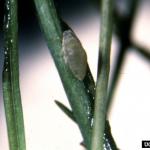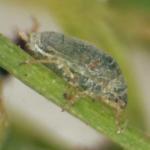Aphid, Asparagus
Brachycorynella asparagi
Identification:
Asparagus aphids are small (1.6 to 2 mm), oval, green to gray aphids that may be covered in a waxy secretion. Unlike many aphids, they have no visible ‘cornicles’, two exhaust pipe-like structures on the tip of the abdomen. They often occur in dense clusters and may be winged or wingless.
Life Cycle:
The asparagus aphid overwinters as an egg on asparagus residue in the field. Eggs hatch in spring and nymphs and adults feed on spears, then on ferns. During the summer female asparagus aphids produce live young (nymphs) without mating or laying eggs. Nymphs develop into reproductive females in 8-10 days. Populations can build up rapidly, especially in hot, dry weather. In the fall, winged males occur, males and females mate and eggs are laid on the lower portion of the ferns for overwintering. Environmental factors that reduce populations include humid summers and cold winters.
Crop Injury:
Aphids feed on new growth and cause shortening of the internodes, rosetting, brush-like or ‘witches broom’ appearance of the foliage, especially near the tips of the lower branches. They also deplete sugars, especially in the roots, and cause reduced root growth. Infected ferns have a blue-green appearance. High aphid populations will reduce plant vigor and yield or kill seedlings. Younger plantings are most vulnerable, especially 2 or 3 year old plantings that are not being harvested. Cold winters and aphid infestation have a synergistic effect on plant health, greater than either factor alone. A combination of heavy infestations and cold winters can kill even full size crowns within two years. Asparagus can vector viruses, including asparagus virus I and II (AV-I and AV-II) and tobacco streak virus (TSV).
Monitoring & Thresholds:
During harvest, monitor younger plantings as well as volunteer asparagus – that is, any plants that are not being harvested. After harvest, scout ferns for signs of feeding injury, and if fern injury is evident, look for aphid colonies. Injury and infestations are most often found in the basal regions of the plant. In the North Central states, the recommended economic threshold for initiating insecticide applications is when 5% of ferns have injury. New plantings and seedbeds can tolerate less foliar injury than established plantings and may require a lower action threshold.
Cultural Controls & Prevention:
- Picking spears provides control of aphids in spring; only volunteer plants and young plantings that are not harvested will allow aphids to survive and multiply.
- A combination of removing dead ferns during the fall or winter and controlling volunteers through spring tillage or herbicides help reduce winter and spring survival.
Biological Controls:
Natural biocontrol is provided by insect predators such as lady beetles, lacewings, predatory midges, and flower fly larvae, by a Braconid wasp that is a parasite of many aphid species, Diaeretiella rapea, and by a fungal pathogen that is more active in humid climates. In many cases, natural controls are adequate to prevent economic damage.
Chemical Controls & Pesticides:
If naturally occurring bio-controls prove insufficient and injury is present on >5% of ferns, treat the ferns twice, about 10 days apart, preferably with an insecticide that has systemic properties or a long residual period.
For current information on production methods (including varieties, spacing, seeding, and fertility), weed, disease, and insect management, please visit the New England Vegetable Management Guide.
Crops that are affected by this insect:
The Center for Agriculture, Food and the Environment and UMass Extension are equal opportunity providers and employers, United States Department of Agriculture cooperating. Contact your local Extension office for information on disability accommodations. Contact the State Center Director’s Office if you have concerns related to discrimination, 413-545-4800 or see ag.umass.edu/civil-rights-information.

